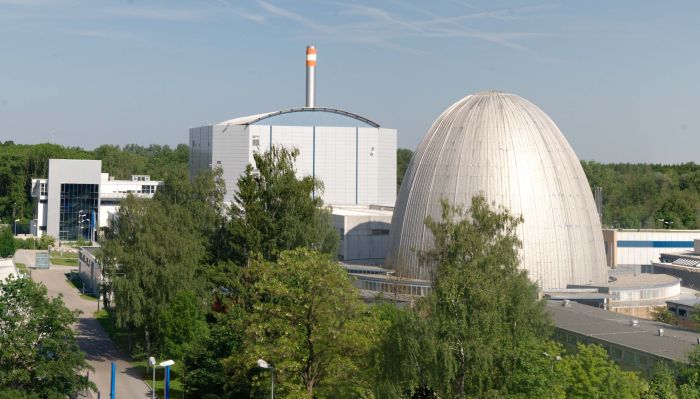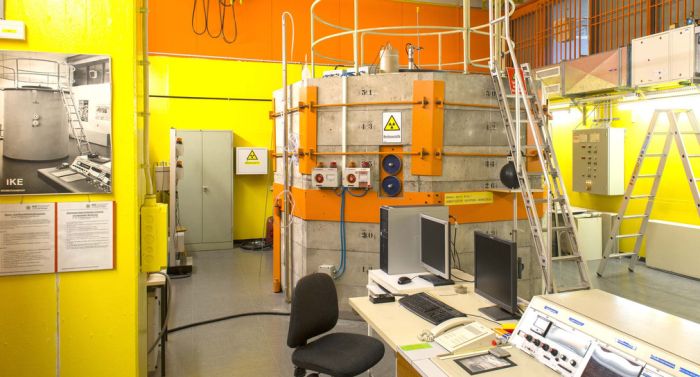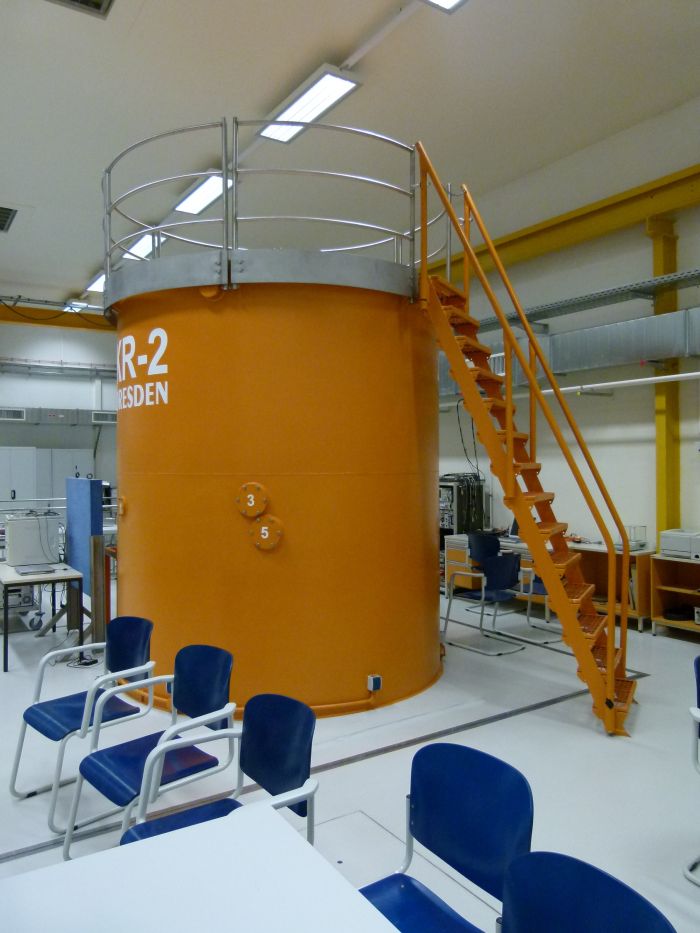
Research reactors in Germany: These reactors may continue to be operated in Germany beyond 2023
Unlike commercial power reactors, research reactors are not designed to produce electricity. They also differ significantly from their big siblings in size, design and mode of operation. Their thermal output is often so low that some of them are also called zero-power reactors. Since these plants require only very small amounts of nuclear fuel compared to nuclear power plants, they also produce correspondingly little high-level radioactive waste.
A distinction must be made between research reactors and prototype reactors, which are used to test the feasibility of new reactor concepts.
Possible uses of research reactors
Research reactors are facilities for research into basic physics, places of education and training, and production sites for radioactive medicines, so-called radiopharmaceuticals. While electricity production uses the thermal energy generated during nuclear fission, research reactors use the neutrons. Some of them are therefore also called "neutron sources".
Research: How can neutrons be captured and used?
Radioactive substances- also known as radionuclides - have the property that their atomic nuclei are unstable and decay after a certain time, emitting ionising radiation. The period of time in which the original quantity of a radionuclide is reduced to half by its decay is called the half-life. In controlled nuclear fission in nuclear reactors, neutrons are used to make atomic nuclei unstable in a targeted manner and thus cause them to decay. In addition to the fission products, further neutrons are released, which then split other atomic nuclei in a chain reaction.
Of these, 1 neutron is needed to maintain a stable chain reaction, i.e. the fission of another uranium atom. To do this, it must be slowed down, since only neutrons of low energy lead to the fission of uranium-235. A so-called moderator - often water or polyethylene - is used for this purpose. The neutrons lose kinetic energy through the collisions with the atoms of the moderator.
In a research reactor, the other neutrons are guided through beam tubes to various experimental stations. Neutrons of different energies are often discharged in the various beam tubes, as monoenergetic neutrons are needed for many experiments. The neutrons are then used for different types of experiments, depending on the research focus.
Training: Teaching in the research reactor
Research reactors mainly used for education and training are also called teaching reactors. Most of them are located at universities. Four teaching reactors are currently still in use in Germany. The reactors are mainly used for teaching technical and scientific subjects or, for example, medical physics. Other than that, schools and interested members of the public also visit teaching reactors to learn about how nuclear reactors work.
Medicine: How are radiopharmaceuticals produced in research reactors?
Certain research reactors specialise in the production of radioactive nuclides for the manufacture of drugs for diagnostic procedures and the treatment of cancer. The challenge in producing such drugs is to take into account the half-lives of the individual radionuclides. Many of the radiopharmaceuticals used today have a short half-life and must therefore be produced "just in time".
Germany's research reactors: Which plants are currently in operation?
Germany currently has six research reactors: the FRM II research neutron source at the Technical University of Munich, the TRIGA Mark II research reactor at the University of Mainz and the four teaching reactors SUR Stuttgart, SUR Ulm, SUR Furtwangen and AKR-2 Dresden. The research reactors are connected to the respective universities and are also financed through them and the respective Länder.
The German research reactors in detail
FRM II. One of the best-known German research reactors is the Heinz Maier-Leibnitz Research Neutron Source (Forschungs-Neutronenquelle Heinz Maier-Leibnitz (FRM II) at the Technical University of Munich (TUM). Located on the Garching research campus, the facility is the newest and most powerful neutron source in Germany. With a thermal output of 20 megawatts (MW), around ten to the fourteenth free neutrons are generated from uranium per second and square centimetre. The neutrons from the reactor, which has been in operation since 2005, are used in science, medicine and industry. FRM II specialises in neutron scattering experiments on beam tubes and neutron guides. But the irradiation of materials and nuclear physics experiments are also carried out here.
The FRM II is a so-called swimming pool reactor. Its reactor core is located in a pool that is open at the top. The pool is divided into a reactor pool and a storage pool, which holds 700 cubic metres of fully demineralised water. The spent fuel elements are stored in it.
The FRM II is operated with highly enriched uranium-235. For years, research has been underway at TUM to convert the reactor to low-enriched uranium-235. A solution now seems to be in sight. In April 2023, the the Bavarian State Ministry of Science and the Arts approved TUM's plan for how to convert the reactor to low-enriched uranium (LEU). Now the preparations for the licensing procedure for the new fuel can start.

TRIGA Mark II at the University of Mainz. Since 1965, the TRIGA Mark II research reactor (FRMZ) has been in use at the University of Mainz as a neutron source in the service of research. The FRMZ has a thermal output of 100 kilowatts (kW). It can reach an output of 250 megawatts at short notice via a pulse facility. The research reactor is one of the so-called TRIGA reactors, which are among the most frequently used research reactor types worldwide. TRIGA stands for "Training, Research, Isotopes, General Atomic". In terms of its design, the TRIGA - just like the FRM II - is a small swimming pool reactor. Uranium is the fuel, while zirconium hydride acts as a moderator to slow down the speed of the free neutrons.
The Mainz reactor is mainly used for applied research and basic research in the fields of nuclear chemistry and nuclear physics.
Siemens training reactor Stuttgart. The Siemens training reactor Stuttgart (SUR) is a small-scale nuclear reactor. The research reactor is designed for a power of 100 milliwatts (mW), but output can also be increased to up to 1,000 mW at short notice. The SUR has been used since 1964 by students and reactor staff for practical courses to demonstrate the neutron source, the basics of nuclear fission, and how to control the reactor. The reactor is equipped with various experimental channels for experiments.
Several fuel moderator plates made of a uranium-polyethylene mixture fill the reactor core. Since the reactor's power output is very low, burn-up - i.e. the consumption of fuel - is very small and the service life of the reactor core is thus practically unlimited - fuel element changes that are necessary in other reactors are not necessary.
The reactor is controlled by two absorber plates with which neutrons can be "captured" so that they are no longer available for nuclear fission. Because of its low power, the reactor does not need cooling. Since the chain reaction is stopped even at a slight increase in temperature, it can be described as inherently safe.

Siemens training reactor Ulm. The Siemens training reactor (SUR) Ulm was first commissioned one year after the SUR at the University of Stuttgart's Institute for Radiation Measurement Technology. In terms of its design, it corresponds to the latter and is also used - as the name suggests - for teaching purposes in the academic field.
To attenuate the radiation, a 10-centimetre-thick lead shield surrounds the reactor vessel and the graphite reflector surrounding it. The lead shielding is in turn surrounded by a water tank.
Siemens training reactor Furtwangen. At the Institute for Radiation Measurement Technology of the University of Furtwangen, a Siemens training reactor (SUR-100) has been in service since 1973 for research and teaching. Among other things, gamma dose rate measurements (local dose rate measurements), radon measurements, contamination measurements and gamma spectrometry are carried out here. The structure and function correspond to those of the two SURs at Ulm and Stuttgart.
Nuclear training reactor II Dresden. The Nuclear training reactor II (AKR-2) is operated at Dresden Technical University. In 2005, it became the most recent German research reactor to receive its operating licence, following a previous conversion of the AKR-1 in 2004.
Just like in the Siemens teaching reactor (SUR), the fuel elements consist of a fuel-moderator mixture of uranium and polyethylene. The thermal power of the reactor is two watts, which is why hardly any fuel is needed.
The chain reaction in the AKR-2 is controlled by cadmium absorber rods. A total of three neutron measuring channels monitor the state of the reactor. There are two experimental channels for measurements and experiments.

How safe are research reactors?
Just like power reactors, research reactors are also subject to state supervision, which is exercised by the respective Länder.
However, the nuclear regulations are applied in a graded manner because of the considerably lower hazard potential. The Western European Nuclear Regulators Association (WENRA)https://www.wenra.eu/ – an association of European nuclear regulatory authorities – established so-called Safety Reference Levels for research reactors in 2022. They formulate uniform requirements for the safety of research reactors. The high level of safety and the corresponding requirements of the Safety Reference Levels for power reactors will be greatly taken into account.
In addition, research reactors are regularly inspected by the European Nuclear Anergy Agency (EURATOM) and the International Atomic Energy Agency (IAEA) due to their fuel inventory. This is to prevent the unauthorised proliferation of weapons-grade nuclear material.
End of the life cycle: Dismantling research reactors
The decommissioning and dismantling of research reactors follow the same principle as for nuclear power plants. First, the dismantling of the reactor must be applied for and approved, followed by decontamination, dismantling and disassembly of the individual components and conditioning of the waste. In contrast to a nuclear power plant, the radioactive inventory and the size of the installation are significantly smaller in a research reactor. In addition, the plant components for electricity generation, such as the turbine and generator, are also missing. The decommissioning of a research reactor can therefore take a few months or years, which is much shorter than that of a power reactor. The decommissioning of a power reactor takes an average of 15 years. So far, 31 research reactors have been completely dismantled in Germany.
Relevance of research reactors for the work of GRS
GRS monitors the international activities on the safety of research reactors. In its own research projects, it investigates and evaluates certain safety aspects in more detail - such as the ageing of components or the dismantling of research reactors.